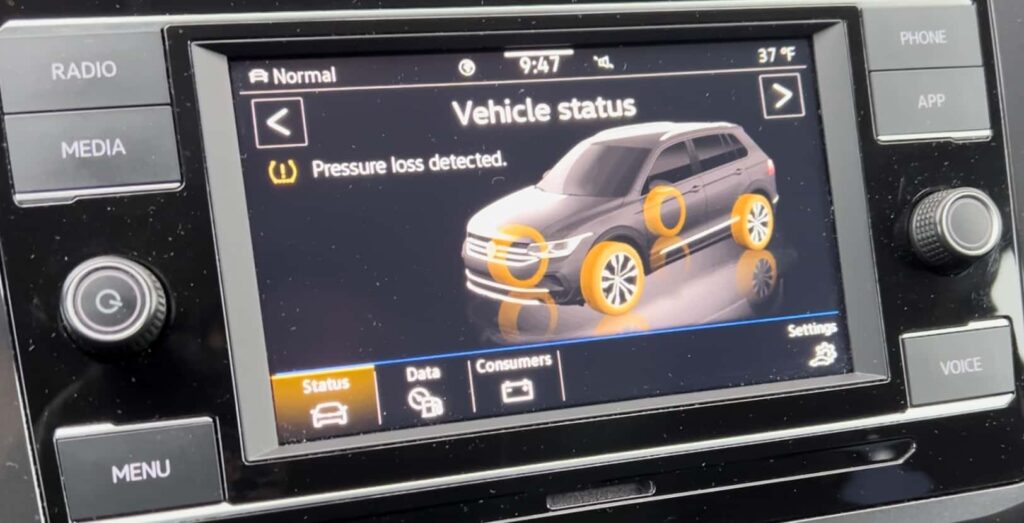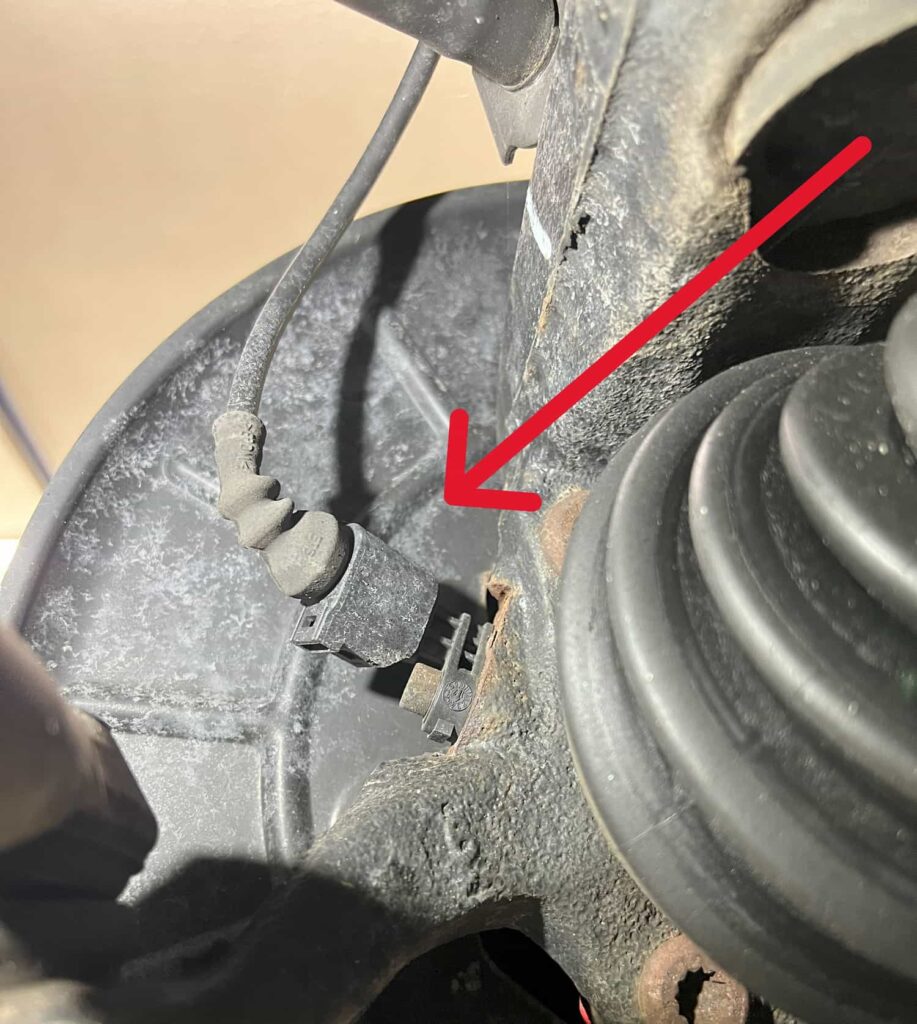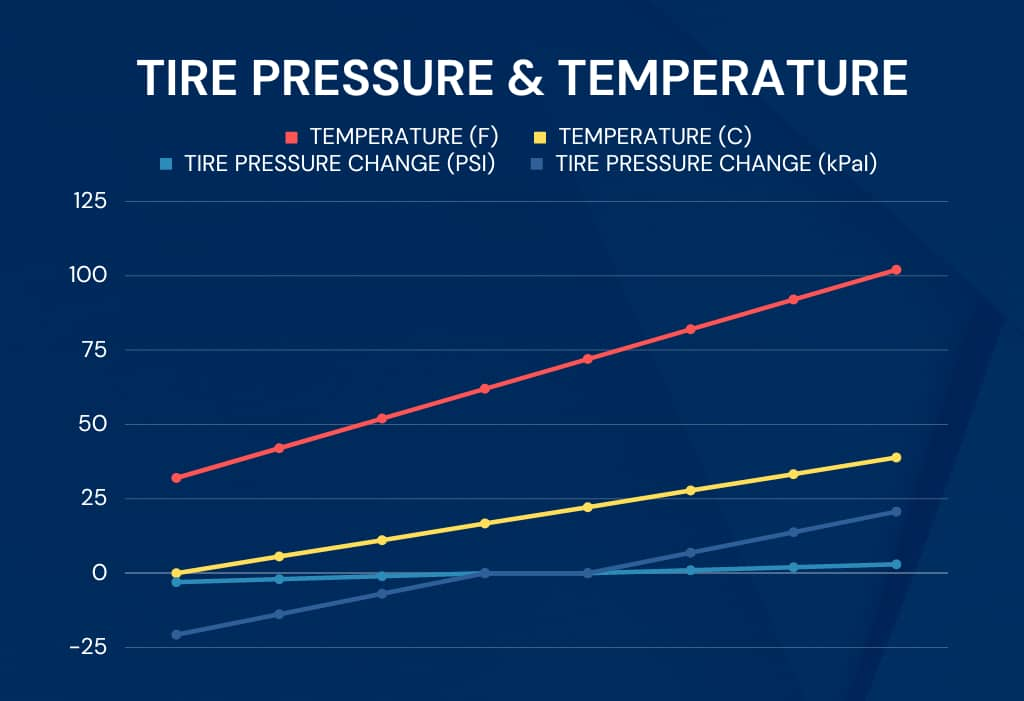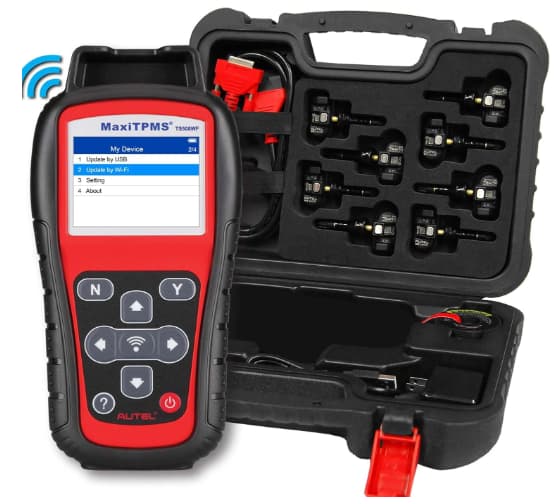Steps to Reset the Volkswagen Low Tire Pressure Light
2010-2014 Volkswagen Vehicles With a TPMS Button
Check and inflate each tire to the exact air pressure that the door sticker recommends.
Start the engine or put the key into the second position without starting it.
Open the glove box.
Push and hold the TPMS reset button. (SET)
You will hear a chime sound and the tire pressure light will turn off.
Drive your VW for 10 minutes at speeds exceeding 25 mph.
How to Reset VW UP Tire Pressure Light
Check and inflate each tire to the exact air pressure that the door sticker recommends.
Start the engine or put the ignition into the second position without starting the engine.
Press and hold the TPMS reset button (SET) located directly above the gear shifter.
The tire light on the dash will flash and then make a chime sound.
Release the SET button.
Drive your VW UP for 10 minutes at speeds exceeding 25 mph.
2014-2018 Volkswagen Vehicles
Check and inflate each tire to the exact air pressure that the door sticker recommends.
Start the engine or put the ignition into the second position without starting the engine.
Press the left arrow button on the right side of the steering wheel to scroll through all the menu options on the display screen until you reach SETTINGS
Press the Down arrow button on the steering wheel to scroll down and select TIRE PRESSURE by pressing OK on the steering wheel.
Select STORE.
Select CONFIRM.
A message will read “tire pressures stored” and you will hear a chime sound to confirm a successful TPMS reset.
Drive your VW for 10 minutes at speeds exceeding 25 mph.
2018-2025 Volkswagen Vehicles
Check and inflate each tire to the exact air pressure that the door sticker or owner’s manual recommends.
Start the engine or press the start button twice without pressing the brake pedal.
Press the CAR button located on the infotainment system display.
Select VEHICLE.
Select SETTINGS.
Select TIRES.
Select SET.
Select CONFIRM.
Drive your VW for 10 minutes at speeds exceeding 25 mph.
2022 Volkswagen GTI
Check and inflate each tire to the exact air pressure that the door sticker recommends.
Start the engine or put the key into the second position without starting it.
Select VEHICLE on the touch screen display screen.
Select TIRE PRESSURE.
Select SET.
Press OK.
Drive your VW for 10 minutes at speeds exceeding 25 mph.
If the Volkswagen Tire Pressure Light Reset Doesn't Work, What Else Can I Try?
Begin by using a tire pressure gauge to check the pressure of each tire before advancing to other troubleshooting measures. It’s essential to verify that each tire is inflated to its correct pressure level, as per the manufacturer’s recommendation. This initial step may quickly rectify the TPMS alert issue by ensuring all tires have the proper pressure.
After inflating the tires, inspect all four tires for leaks by applying soapy water to the treads, tire beads, and valve stems. This method will help you identify any areas where air may be escaping.
To potentially clear any TPMS fault codes, temporarily disconnect the negative terminal of the battery for a few minutes, which resets the Volkswagen vehicle’s computer system.
Adjust the pressure in each tire by deflating them approximately 10 psi, then reinflate them to the recommended pressure. Drive your VW for at least 10 minutes at speeds exceeding 20 mph and proceed with the TPMS reset process.
Utilize an OBD scan tool to pinpoint any fault codes related to the tire pressure monitoring system within the onboard computer. Verify the functionality of each wheel speed sensor to ensure accurate tire pressure monitoring.
How Does the Volkswagen Tire Pressure Monitoring System Work?
The Volkswagen indirect Tire Pressure Monitoring System (TPMS) does not use dedicated sensors in the vehicle tires. Instead, it relies on the Anti-lock Braking System (ABS) to monitor the rotational speed of each wheel. When tires lose pressure and become underinflated, its diameter decreases slightly, causing it to rotate faster than the properly inflated tires. The VW TPMS system detects this difference in rotational speeds and illuminates the TPMS warning light on the dashboard.
Volkswagen vehicles built between 2006-2011 used direct tire pressure monitoring systems. This means the tire pressures in each tire is measured using a tire pressure sensor within each tire. The Volkswagen UP vehicles use a direct TPMS system.
Why is My Volkswagen Low Tire Pressure Light On?
Using non-OEM size tires or wheels that have a different diameter/circumference than the original tires can cause the TPMS light to illuminate.
Driving with the spare tire installed, since the spare typically has a different size than the regular tires.
Drastic temperature changes, especially dropping temperatures, can cause the air pressure in the tires to decrease and trigger the TPMS light.
Uneven tire wear across the tires can lead to differences in rotational speeds that the indirect TPMS interprets as a low pressure condition.
After rotating the tires or properly inflating all tires, the indirect TPMS may need to be reset manually for it to turn off the warning light.
A malfunctioning wheel speed sensor or issue with the ABS system that the indirect TPMS relies on for data.
Electronic or software issues with the TPMS module itself can cause erratic behavior or false warnings.
Why is My Tire Pressure Light Still on After Filling Tires on a Volkswagen?
If the tire pressure light remains on after you’ve inflated your tires to the correct pressure, there could be a few reasons:
The TPMS system may need to be reset manually after adjusting the tire pressures or rotating the tires.
There may be a problem with the TPMS system itself, causing inaccurate readings or a failure to reset properly.
The tire pressures may not have been set to the recommended levels for your specific Volkswagen model and load conditions.
The VW may need to be driven for the TPMS to accurately see the changes in air pressure.
Why is My TPMS Light Flashing?
A flashing TPMS light on your Volkswagen typically indicates a more serious issue with the system itself. It could mean that the TPMS system is malfunctioning or that there is a problem with the ABS system, which the TPMS relies on for its data. If the tire light is flashing, it’s recommended to either have your Volkswagen dealer or a qualified mechanic diagnose and repair the issue, or connect an OBD2 scan tool to the vehicle and find out which fault codes are on and why.
Can I Drive My VW With the Tire Pressure Light On?
While it is generally safe to drive with the tire pressure light on for a short distance, it’s not recommended to continue driving for an extended period. Underinflated tires can lead to poor handling, increased wear, and even a blowout in severe cases. It’s best to address the issue as soon as possible by checking and adjusting your tire pressures, or seeking professional assistance if the light remains on after inflating the tires.
Do Volkswagen Vehicles Have Sensors in the Tires?
No, Volkswagen vehicles with indirect tire pressure systems do not have TPMS sensors within each wheel and tire.
Can I Permanently Disable My VW Tire Pressure Monitoring System?
No, the VW tire pressure monitoring system is a federally mandated safety feature that all Volkswagen cars come with since 2008.
Will Cold Weather Cause My Tire Light to Turn On?
Yes, dropping temperatures can cause the tire pressure light to turn on in your Volkswagen. As the air inside your tires cools, it contracts and loses pressure. Factually, for every 10 degree Fahrenheit drop in air pressure, tire air pressure will drop by about 1-2 psi.
This is a normal phenomenon and can occur over the course of a day, a week or a month. The pressure can return to normal once the tires warm up again from driving or as the air temperature increases. Regardless, anytime the tire light on the dashboard turns on, use a tire pressure gauge to manually check the air pressures. If the air pressure in all the tires has dropped by a few psi, it is likely from natural air loss or the change in temperature. If one tire has lost air pressure but the rest have not, you likely have some kind of leak.
For Specific guides on your Volkswagen car, check out these guides:
Volkswagen Golf, Volkswagen ID.4, Volkswagen Arteon, Volkswagen Taos, Volkswagen Passat, Volkswagen Tiguan, Volkswagen GTI, Volkswagen Jetta, Volkswagen Atlas, Volkswagen Beetle.
Please note that this blog post contains Amazon affiliate links. This means that if you make a purchase through one of these links, we at TPMSRESET.COM may earn a small commission at no extra cost to you. We only recommend products that we personally use and believe in. Thank you for supporting us.
About the Author
Stefan A. – Professional Automotive Technician – I am currently an automotive technician in New Jersey and have worked in private shops as well as dealerships. When I am not writing articles I am wrenching on race cars and driving radio controlled cars at the track!






